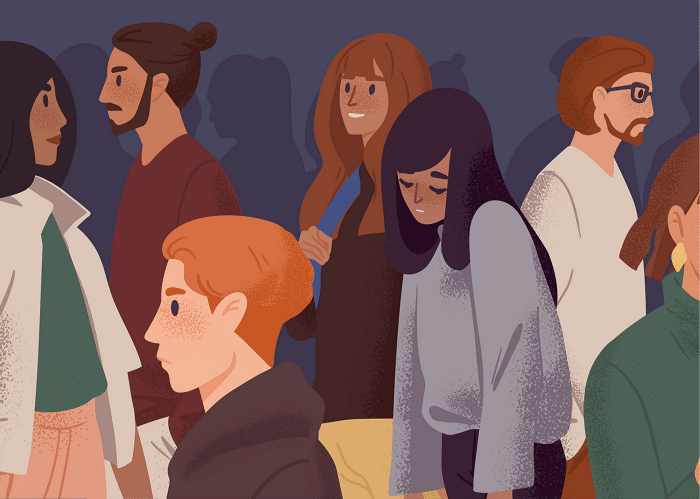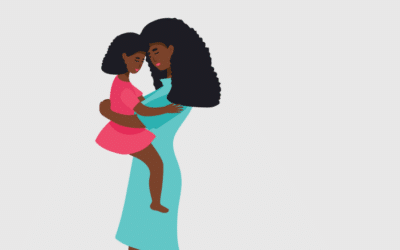Our brain’s survival mechanisms once saved us. Now they can threaten our mental health.
Long before the coronavirus pandemic mixed fear and uncertainty into daily life, Americans felt stressed out.
They worried about the country’s rising health care costs, struggled to pay them, and wondered if they could even access care in the future. One-quarter of U.S. adults reported discrimination—based on race and gender—as a significant source of stress. And on an individual level, work and money ranked as the top two major stressors, all according to a 2019 study.
Wherever constant stress lives, so too does its more agitated and debilitating cousin: anxiety. About 31% of Americans will experience an anxiety disorder at some point in their lives, with adult and teen women experiencing one far more often than men, according to the U.S. National Institute of Mental Health.
What’s more, anxiety often goes hand-in-hand with depression. Nearly half of people diagnosed with depression also have an anxiety disorder, according to the Anxiety and Depression Association of America. At any one time, “about 7% of the U.S. population meets criteria for a major depressive disorder,” says Rachel Katz, MD, a psychiatrist at Yale Psychiatric Hospital.
As if those statistics weren’t worrying enough, enter the global pandemic that has upended daily life in numerous ways, leaving millions of Americans without a job, and producing far more questions than answers. When will we be safely able to move about our lives? Will the kids go back to school in September? Will I lose my job? Will I or someone I care about get sick?
“With these concerns, the experience right now is, ‘I don’t have a lot of control over what is happening around me,’” says Carolyn M. Mazure, PhD, a Yale Medicine psychologist and director of Women’s Health Research at Yale.
Feeling a lack of control over a situation can lead to stress, anxiety, and even depression. Recognizing the differences between the them can lead to the right treatment.
What is Stress?
Stress is a physical response to a situation. When the brain receives a threatening signal, a flood of chemicals overwhelms the rational, more evolved part of the brain, called the prefrontal cortex. Neurotransmitters, including dopamine and norepinephrine, activate the amygdala, a more primitive part of the brain that evolved to prepare the body’s “fight or flight” response in the face of, say, a lion.
Another biological process that arises is a combination of nerve and hormonal signals that causes your adrenal glands to release the hormones adrenaline and cortisol. Your heart beats faster and your breathing becomes shallower as your body gears up to react to a situation; this makes it difficult to reflect with the calmer emotion, measured logic, and impulse check that the prefrontal cortex offers. Millions of years ago, this intricate process saved our lives. Today, in the face of daily stressors, it threatens our collective mental health.
This a uniquely modern problem. “In contemporary society, individuals are stressed for long periods of time,” Mazure says. “In this situation, stress no longer serves its initial biological function of alerting us; its function becomes corrupted when it is chronic or prolonged and you cannot turn it off.”
Constant exposure to stress can cause physical problems such as headaches, constipation, diarrhea, chest pain, insomnia, and grinding teeth. Left unchecked, stress can increase a person’s risk of high blood pressure, heart disease, diabetes, and obesity. “It’s also thought to play a role in autoimmune disease,” Mazure adds. Stress has also been linked to a weakened immune system, causing people to be more susceptible to catching colds and other infections.
Mazure offers tips for interrupting and reducing our stress—during the pandemic and after—that can be applied to everyday life.
Prioritize Exercise and a Balanced Diet.
“By now this advice might seem worn out. But those two things are important—they really are,” Mazure says. Altering your routine to include walking, running, biking, aerobics or yoga classes, and trying to bring more fruits, vegetables, and whole grains into a daily diet are not small changes or easy ones, but they can reduce stress and improve the way you feel, she says.
Establish a Routine
Studies have shown that the predictability of routine can help fight the out-of-control feelings that stress can cause. “The reality is increasingly clear that this pandemic is unlikely to have a rapid resolution,” Mazure says. “We need to build a personal structure or routine that is rewarding and that brings us a sense of control.”
Do Things that Have Personal Meaning for You.
“One of the central aspects of resilience is feeling that you have purpose in life,” Mazure says. “To ensure this, remind yourself what is important, remember your values, and value your relationships.”
Persistent stress that feels unmanageable can lead to anxiety and depression.
What is Anxiety?
Anxiety shares the same physical and biological elements as stress. Two differences are that stress-induced neurotransmitters and hormones stay ramped up and our minds get stuck in repetitive worry, or panic-driven thought loops.
“Think of anxiety as a normal reaction to a situation where people feel pressured and, to some degree, fearful because there’s an unknown factor or a perceived danger,” says Michelle Alejandra Silva, PsyD, assistant professor of psychiatry at Yale School of Medicine and director of the Connecticut Latino Behavioral Health System. “But it becomes clinically concerning when the feeling persists even when the threat is not there, and when it begins to interfere with day-to-day functioning and relationships.”
Anxiety can also be described as feeling that one’s internal resolve and strength is outmatched by an external stressor, Silva explains.
Any single cause or the combined weight of numerous factors can lead to an anxiety disorder. Anxiety triggers can be obvious, like losing a job or house, or more difficult to pin down, such as traumatic events from one’s past.
“Understanding context is key,” Silva says. “I try to do a thorough assessment of patients’ current environment and circumstances to understand their feelings and experiences within their reality. For instance, many of my clients are dealing with poverty or immigration-related stressors.”
Silva recommends several tips to help with anxiety.
Engage in an Activity that Requires Mindfulness.
Repetitive anxious thoughts might fixate on something that happened in the past or latch onto worrying about an unknown future. “Anything that helps us stay in the present, like journaling, coloring, or practicing meditation, can help interrupt anxiety,” Silva says.
Practice Self-Compassion
“We all experience anxiety to some degree—it’s a very normal feeling,” Silva says. She emphasizes the importance of accepting your uncomfortable feelings rather than judging yourself for whatever you are experiencing.
Seek Professional Help
“There’s still a significant stigma when it comes to mental health services,” Silva says. However, she emphasizes that programs and health care providers can help with a variety of treatments, including individual or group therapy and possibly medication.
If anxiety is particularly severe or prolonged, it can become intertwined with depression, a disorder that can look very different from one person to another, but that tends to share a common theme: an inability to enjoy life.
What is Depression?
Unlike stress and anxiety, less is known about the causes, symptoms, and mechanisms of depression. Its debilitating nature can cause people to lose the ability to function in all areas of life, including work and relationships. The World Health Organization (WHO) ranks depression as a leading cause of disability worldwide. The disorder can be deadly when it leads to suicidal thinking and planning. “We lose nearly 50,000 people each year to suicide in the U.S. and that rate seems to be increasing,” says Gerard Sanacora, MD, PhD, a Yale Medicine psychiatrist and director of the Yale Depression Research Program.
“Many of my patients say depression literally hurts,” Silva says.
Physical symptoms of depression can include weight loss or gain, poor sleep, physical pain, and speaking or moving more slowly than normal. Its mental manifestations can include persistent sadness, hopelessness, anxiety, and mental paralysis.
“If someone feels like a burden, they are less likely to reach out to others, and could end up socially withdrawing,” Silva says.
“Depression can lead to ruminative thinking and feelings of guilt, and it can impair a person’s ability to think or concentrate and form memories,” Dr. Katz says.
In the past decade, researchers have shifted from considering depression to be a biochemical imbalance of neurotransmitters—like serotonin, dopamine, and norepinephrine—to a broader view of the disease, which can also be caused by changes in electrical activity between neurons, or nerve cells, in the brain. “With depression, the ability of neurons to connect with each other is decreased,” Dr. Katz explains.
“We don’t yet have a good imaging study or biomarker that lets us know if someone is depressed and what kind of depression they have, or why they have it,” Dr. Katz says. “We make a diagnosis through clinical evaluation and questionnaires that assess common symptoms.”
Not being able to pin down the fundamental causes of depression means that treatment, while effective for some, relies mainly on a trial-and-error approach. “Unfortunately, we’re still not at a point in treating depression where we have a reliable test that can predict which treatment will work better than others,” Dr. Sanacora says. “We’re getting close, and some research that’s being done now will, we hope, get us closer within the next decade, but we’re not quite there yet.”
Nevertheless, psychiatrists, who prescribe medication (and may also provide therapy), as well as psychologists or therapists, who specialize in different types of therapy, can deliver personalized care for patients that can be, for many, effective. Treatment for depression varies for every individual, and may include a combination of medication and therapy.
For many, professional help is an important or essential step on the road to recovery, says Silva. She gives two other ideas that may provide some temporary relief from the disease.
Exercise
Many studies have pointed to the powerful positive effect regular exercise can have on a person’s mental health. “With depression, we see a lot of rumination; exercise can interrupt that in the short term,” Silva says.
Connect with Others
This advice may seem particularly challenging as social distancing and shelter-in-place measures are still in place in much of the country. However, a phone call or Zoom meeting with a family member or friend may help. “Remember that social distancing is about physical distancing, but connecting with others can still happen, even virtually,” Silva says.
Here’s the hopeful message: Stress, anxiety, and depression are universal human experiences. No matter how you experience these feelings or disorders, know that you can seek professional help and that you are not alone.
Want More?
If you enjoyed this article, check out the rest of our blog today and make sure to follow us at Youth Dynamics of Montana and People of Youth Dynamics on Facebook.






